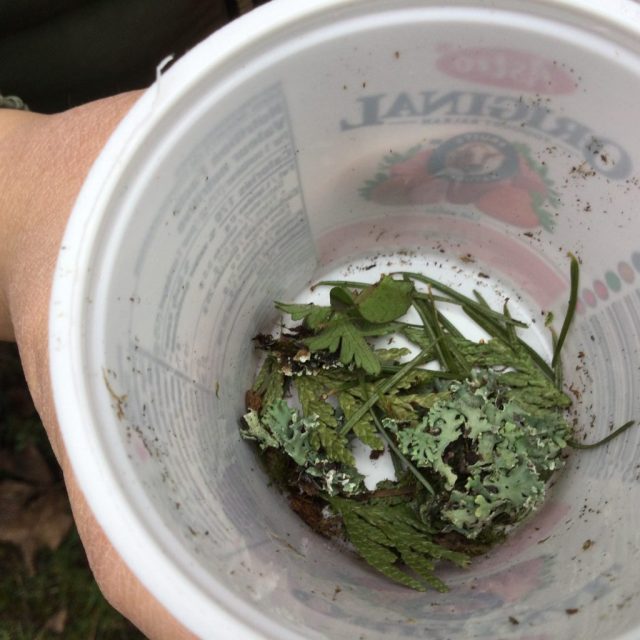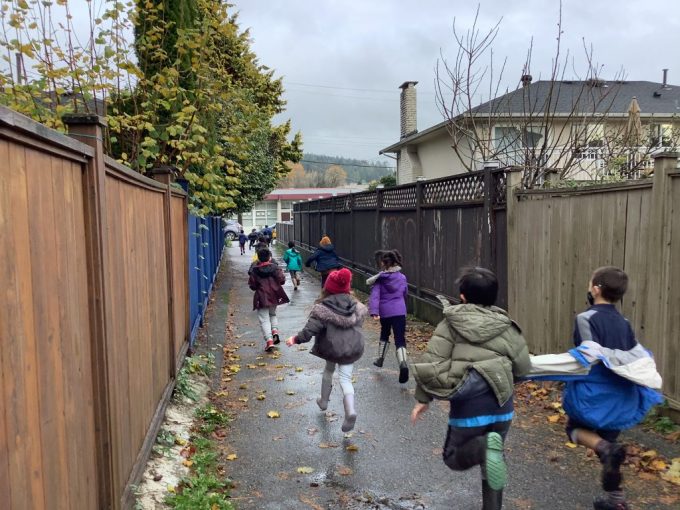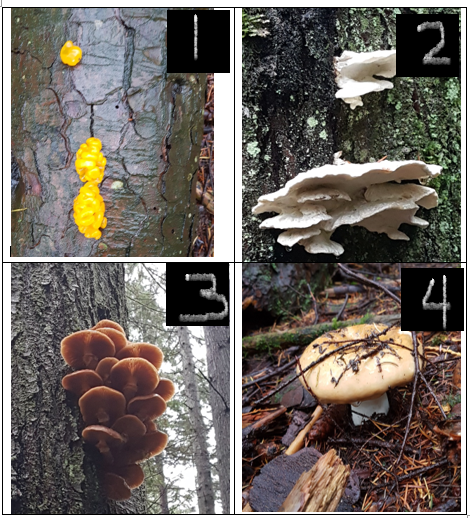Spring is here! On today’s nature walk, students were asked to look for what’s growing. How do they know something is growing? What clues can they look for?
Learning adventures in a Grade 2 French Immersion classroom
 Students were asked to create a forest ‘perfume’. We discovered that le cèdre was the most fragrant. Other plants were used, such as clover, lichen, or fir needles. Some even threw in pinecones and dead leaves for an especially earthy smell!
Students were asked to create a forest ‘perfume’. We discovered that le cèdre was the most fragrant. Other plants were used, such as clover, lichen, or fir needles. Some even threw in pinecones and dead leaves for an especially earthy smell!
As always, we only collected plants from the forest floor. We’re aiming to not harm living plants. We’re also aiming to not disturb our local ecosystem.
Sometimes, we get inspired by nature to make art. In this math activity, students were asked to create 2D picture art with sticks. They were asked to only use 12 sticks and for them to be as straight as possible. Then, they were asked to identify shapes within their art.
We counted sides and noted the number of vertices. We practiced using words like un triangle, un carré, un rectangle…We started identifying special polygon shapes too, like un hexagone.
We ran out of time, but it would have been interesting to extend this activity by only using ‘small’ sticks. How would their picture art change? What if a range of stick lengths were used instead? Would that change the picture again?
This activity was taken from the fantastic book, Messy Maths, by Juliet Robertson.
We’re learning that cedar was and continues to be an important tree for local Indigenous peoples.
We noticed there are many cedar trees near our school. On this nature walk, we focused on the branches, noting its flat needles and drooping shape.
When students rubbed its needles, they noted how good cedar smelled!
Some students found a branch from a neighbouring evergreen tree. We observed that the needles were different. They seemed sharper and bushier but were also flat. Its colour was a lighter green.
 We continue to explore Dr. Gillian Judson’s walking curriculum. On this nature outing, students were asked to look for ‘beautiful’ and ‘not beautiful’ elements around our school.
We continue to explore Dr. Gillian Judson’s walking curriculum. On this nature outing, students were asked to look for ‘beautiful’ and ‘not beautiful’ elements around our school.
Rocks, lichen, and flowers were beautiful to most students; litter wasn’t beautiful. Mushrooms, specifically decaying mushrooms, drew a mixed reaction. Est-ce que c’est beau ou pas beau?
What about invasive species? Can they be beautiful? One student pointed out an invasive ivy plant. He considered it ‘pas beau’ for its damaging effect on our local ecosystem.
We next want to examine our findings and question how all things spotted on our walk may help our environment. Of course, it’s possible that not all of them can!
Ce qui est beau:
Ce qui n’est pas beau:
Voici quelques champignons observés derrière notre école. Here are some mushrooms observed behind our school.
As always, we practiced our personal and social responsibility by not touching wild mushrooms, especially toxic ones like the red-capped Fly Agaric (Amanita muscaria).
We’re learning more about fungi and their role in our local ecosystem. To help us, we’re reading Elise Gravel’s Le fan club des champignons.
Math routines are an important part of our math program. One such routine is called “Which One Doesn’t Belong?” or WODB in English. In class, we’ve translated it to Quel est l’intrus?
Students must identify and explain which image doesn’t belong. There may be a few possible answers. Rather than it be about finding the ‘right’ answer, the focus is on explaining why their answer makes sense to them.
In math, we’re learning that we need to be precise and logical with our ideas. Students practice a few core competencies in this activity – communication, critical thinking, and creative thinking.
Recently, on a hike, I spotted four different mushrooms. Together, we discussed which one didn’t belong. One student reasoned that Mushroom #1 didn’t belong because it was more narrow than the others. Another said that Mushroom #4 didn’t belong because it was the only one growing on the ground rather than on trees. Someone else added that Mushroom #4 was the only one that grew alone rather than in clusters.
One student reasoned that Mushroom #1 didn’t belong because it was more narrow than the others. Another said that Mushroom #4 didn’t belong because it was the only one growing on the ground rather than on trees. Someone else added that Mushroom #4 was the only one that grew alone rather than in clusters.
This math routine had us talk about form, size, colour, quantity, and orientation. Not only were we thinking like mathematicians but also like scientists!
We were curious to identify these local fungi. With the help of books and the Internet, we think:
Finally, we talked safety. We understood to never touch or eat wild mushrooms. There are too many lookalike mushrooms, and it’s often tricky to tell apart poisonous ones from non-poisonous ones.
Students understood that it’s always best to simply observe a mushroom. In doing so, we respect their place in our local ecosystems and leave them be.
On today’s nature walk, we looked for signs of fall. We noticed the usual changing of leaf colours, but we also noticed other clues. You can find them in the slideshow below.
Division 10 students have been practicing their reading stamina since our first full week together. We decided what three rules were most important when we read to ourselves.
Overall, students have been increasing their endurance. We debrief every day’s session and self-assess how we did. Did we stay in one spot? Were we calm and focused? Did we read?
We refer to the chart to analyze data and see if we can notice trends. A bit of math gets thrown into our literacy routine! Below, you can see our first completed chart as well as our three golden rules.